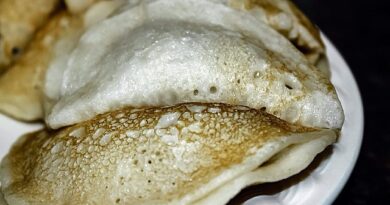Sfenj
The Irresistible Moroccan Doughnut That Transcends Borders
Introduction:
Nestled in the heart of Moroccan cuisine, Sfenj emerges as a delectable delight that has captivated taste buds and earned a special place in the hearts of food enthusiasts worldwide. Often referred to as the Moroccan doughnut, Sfenj is a deep-fried pastry with a history as rich and diverse as the flavors it imparts. In this exploration of Sfenj, we’ll unravel its origins, delve into its ingredients and preparation, and uncover the cultural significance that makes it a beloved treat both in Morocco and beyond.
I. The Rich History of Sfenj:
Sfenj’s roots can be traced back to the Maghreb region, where the interplay of diverse cultures has contributed to Morocco’s vibrant culinary landscape. The word “Sfenj” itself is derived from the Arabic word “sfanja,” which refers to a sponge. This alludes to the doughnut’s characteristic spongy texture, a result of the unique preparation method that has been passed down through generations.
Historically, Sfenj has been associated with festive occasions, family gatherings, and celebrations. It holds a special place in Moroccan culture, symbolizing warmth, hospitality, and the joy of shared moments.
II. Ingredients That Create the Magic:
The simplicity of Sfenj lies in its humble ingredients, carefully combined to create a dough that transforms into golden, airy perfection. The key ingredients include:
- All-Purpose Flour: The foundation of Sfenj’s dough is made with all-purpose flour, providing the structure and texture that make this pastry so irresistible.
- Yeast: A leavening agent, yeast is crucial for creating the characteristic fluffiness of Sfenj. It interacts with the other ingredients, causing the dough to rise and develop its airy quality.
- Water: Sfenj dough requires a careful balance of water to achieve the desired consistency. The hydration process is crucial for creating the spongy texture that sets Sfenj apart.
- Sugar: A touch of sweetness enhances the flavor profile of Sfenj, contributing to its irresistible taste.
- Salt: A pinch of salt is added to balance the sweetness, intensify the flavors, and create a well-rounded dough.
- Vegetable Oil: Both in the dough and for deep-frying, vegetable oil imparts a richness that elevates the texture and flavor of Sfenj.
III. The Art of Sfenj Preparation:
Making Sfenj is not just a culinary process; it’s a cultural tradition passed down through generations. The preparation involves the following steps:
- Activating the Yeast: The yeast is activated by combining it with warm water and a pinch of sugar. This mixture is left to sit until it becomes frothy, indicating that the yeast is active and ready to work its leavening magic.
- Creating the Dough: Flour, sugar, and salt are combined in a bowl, and the activated yeast mixture is added. Slowly, the ingredients are mixed and kneaded to form a soft, elastic dough. This dough is left to rise until it doubles in size.
- Shaping the Doughnuts: Once the dough has risen, it is carefully shaped into rings or rounds, creating the classic doughnut shape. This step requires a skilled hand to achieve the perfect balance between thickness and fluffiness.
- Deep-Frying to Perfection: The shaped doughnuts are then deep-fried in vegetable oil until they achieve a golden-brown hue. The spongy texture develops as the dough expands in the hot oil, creating a delightful contrast of crispy exterior and soft interior.
- Optional Garnishes: While traditionally served plain, some variations of Sfenj include a dusting of powdered sugar or a drizzle of honey, adding an extra layer of sweetness and visual appeal.
IV. The Cultural Significance of Sfenj:
Sfenj is more than just a sweet treat; it is a cultural icon that embodies Moroccan hospitality and the joy of communal dining. In Morocco, Sfenj is often enjoyed during special occasions such as weddings, religious celebrations, and family gatherings. Its presence at festive events symbolizes abundance, generosity, and the pleasure of sharing good food with loved ones.
The act of making Sfenj is also a communal affair. Families and communities come together to prepare and savor these delightful doughnuts, creating lasting memories and strengthening bonds.
V. Sfenj Around the World:
While Sfenj has its roots in Moroccan culture, its popularity has transcended borders. Moroccan communities around the world have introduced Sfenj to new audiences, garnering appreciation for its unique texture and flavor. In recent years, Sfenj has found its way onto the menus of international bakeries and food festivals, captivating the palates of those seeking a taste of the exotic.
VI. Variations of Sfenj:
As with many traditional dishes, Sfenj has seen creative variations and adaptations. Some recipes incorporate additional ingredients such as orange blossom water, anise seeds, or sesame seeds to infuse unique flavors into the dough. These variations pay homage to the adaptability of Moroccan cuisine while retaining the essence of Sfenj’s cultural heritage.
VII. Conclusion:
In conclusion, Sfenj is a culinary treasure that embodies the essence of Moroccan culture, history, and the art of creating a delectable treat that transcends boundaries. Whether enjoyed in the bustling markets of Marrakech or savored in a cozy kitchen halfway across the world, Sfenj invites us to partake in a shared experience of flavor, tradition, and the joy of breaking bread together.
As we indulge in the irresistible allure of Sfenj, let us celebrate the cultural richness it brings to our tables, fostering a deeper appreciation for the diverse and enchanting world of Moroccan cuisine. Sfenj is not just a doughnut; it’s a cultural journey that invites us to savor the sweetness of tradition and the warmth of shared moments.



